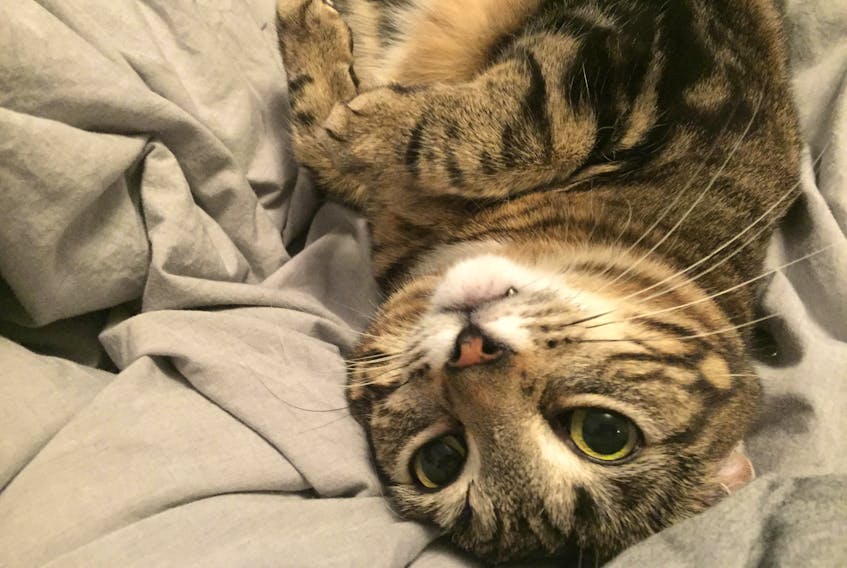Almost a year ago I walked into the Exploits Valley SPCA with no intent other than to look at cats and kittens in person.
I had been watching for new pictures on their adoptables Facebook page for months, sharing the posts with family and friends each time another adorable face popped up on my screen. Within 15 minutes I had a little ball of black and white fur cuddled into my arms, ready to go home. He was a very young feral rescue but he had no trouble adapting to his new life.
I named him Jigger because he didn’t have a name yet, and we thought it was fitting given he was from Belleoram. He might not be a little ball of fur today but he continues to steal my heart every time he looks up at me with those loving eyes, even after digging his claws into my dining room chair for the fourth time in a week.
Cats are naturally predatory animals. They love to hunt mice, birds, and sometimes the elusive plastic bag. Their claws facilitate this behaviour along with self-defence, marking territory, climbing, and balance. Cats walk on their toes, making their claws that much more important in keeping them steady on their feet. Despite the ample evidence of importance that favours keeping a cat’s claws intact, it was only the beginning of November that the college of veterinarians in Newfoundland announced the prohibition of declawing, the removal of a cat’s claws, starting Jan. 1, 2019.
The procedure has been likened to cutting off a human’s fingers to the second knuckle. It is considered medically unnecessary in the majority of cases.
Declawing has been practiced in Canada for a number of years, although it has already been banned many other countries including Australia, England, Israel, and Portugal. In the past year both British Columbia and Nova Scotia have also banned the practice, and Prince Edward Island has decided to ban in 2019 as well.
The procedure has been likened to cutting off a human’s fingers to the second knuckle. It is considered medically unnecessary in the majority of cases.
There are many arguments for and against declawing. Some owners cite preference of preserving furniture they worked for, personal experience with a declawed cat, lack of perceived need for defense mechanisms, and uncontrolled aggression. Many also argue that with the declawing ban in place there will be a greater number of cats in shelters with less demand for adoptions. On the other hand, not declawing your cat spares them pain and suffering, later complications, and behavioural issues that may arise from the lack of self-defense mechanism.
Kittens and cats don’t have to be declawed to mitigate furniture scratching and destructive behaviours. Trimming a cat’s claws is an inexpensive alternative. Although not all cats take well to it initially, they will gain tolerance with time. Buying various scratching posts and boards will provide the cat with an adequate opportunity to scratch. If there is a problem piece of furniture, such as a couch arm, place a scratching board nearby and include catnip to further entice the cat. There are also special tapes that deter animals from scratching furniture. Claw caps can also be purchased and are a better alternative than removing the claws completely. Caps can be glued to the nails and replaced every few weeks.
As a pet parent it is your responsibility to provide these opportunities safely for both you and your cat. The risks involved do not outweigh the rewards.
In my opinion, there is almost never a reason to declaw a cat. Just as you do not prevent a child from playing with toys and making a mess, you cannot prevent a cat from using their claws for scratching behaviour.
As a pet parent it is your responsibility to provide these opportunities safely for both you and your cat. The risks involved do not outweigh the rewards.
While I would never love a declawed cat any less, I am overjoyed that the decision has been made to end this procedure and prevent future suffering. Although the argument of less adoptions may hold weight for some, if you value a piece of furniture over your furry children’s quality of life then I’m not sure that you are meant to be a cat’s parent. In fact, I believe that the absence of declawing may lead to improvement with less declawing related behavioural issues.
So even though my dining room chairs suffer on almost a daily basis, I wouldn’t have it any other way. While I can save up and buy new chairs, I could never buy back a cat’s health and wellbeing.
Jigger can scratch on, and I will continue to find creative ways to let him enjoy his nature. My next investment just might be a six foot cat tree.
Kirsten Dalley is a biology student, published writer, and robotics enthusiast from central Newfoundland.
RELATED:









